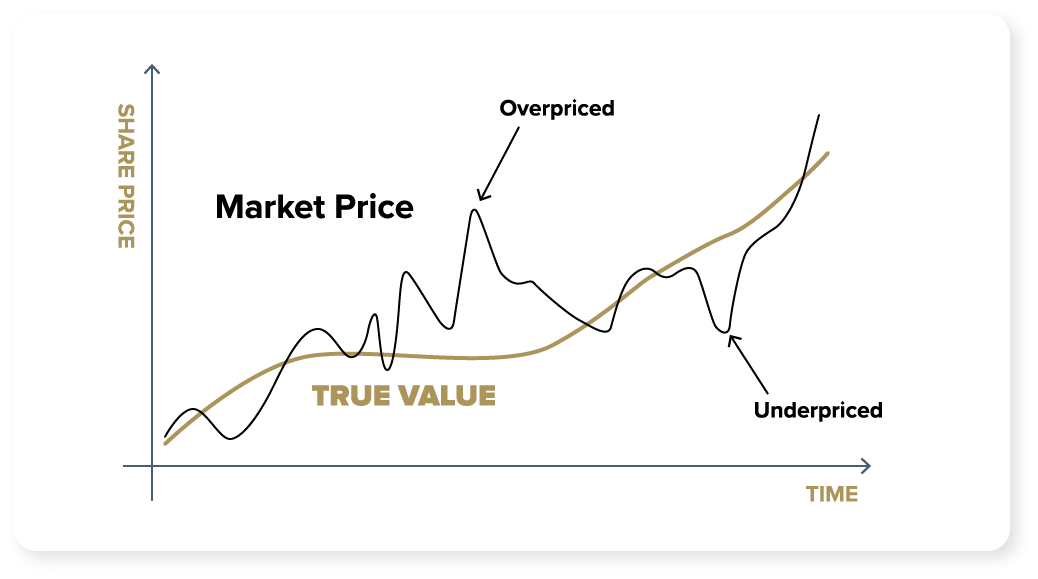When you buy a stock, you’re not just buying a ticker symbol that goes up and down — you’re buying a piece of an underlying business. So, if the business does well, the stock’s market price will most probably do well over time.
Table Of Contents:
What Is “Intrinsic Value” in Stock Investing?
Why It’s Important to Calculate Intrinsic Value
How Intrinsic Value Is Calculated: 2 Stock Valuation Methods
1. PEG Ratio: PE Ratio Versus Earnings Growth Rate
2. Discounted Cash Flow from Operations (DCF)
Things to Note about Calculating Intrinsic Value
Not All Stocks Should Be Valued the Same Way
Intrinsic Value May Change Based on a Company’s Fundamentals
A great business can be a lousy investment if you pay too high a price for it. But a great business can also be a fantastic investment if you pay a low enough price for it.
So what’s expensive, and what’s cheap? You can’t simply look at the stock price itself.
You have to learn to calculate its intrinsic value.
That’s where an intrinsic value calculator comes in handy!
What Is “Intrinsic Value” in Stock Investing?
You may be wondering, “What exactly is intrinsic value (IV)?”. So let us explain it in simple terms:
Let's say you’re looking to buy a car. The intrinsic value of the car would be based on its make, model, mileage, condition, and other fundamental qualities that contribute to its overall value. On the other hand, the price that the seller is asking for the car may be influenced by other external factors such as supply and demand, their urgency to sell, or the current perceived value of the car in the market.
For us investors, intrinsic value is simply the true worth of any business, based on factoring in and calculating its assets, earnings potential, growth prospects, and other fundamental factors.
While the current price (or Market Value) of the business’s stock may fluctuate daily, its IV is determined by its fundamentals.
Why It’s Important to Calculate Intrinsic Value
One of the greatest mistakes that investors make is overpaying for stocks.
They see a stock trading at two-digit prices and think, “This looks cheap! It fits my account size,” or they see the share price dropping and they go, “Hmm the share price has dropped X%, it looks cheap to buy now!”
But what they don’t realize is that the stock’s true worth could be much lower.
This is where IV comes into play. It essentially tells you whether the stock you’re looking to invest in is expensive (overvalued) or cheap (undervalued)!
Rather than focus on short-term price fluctuations, having knowledge of calculating IV would enable you to make better-informed decisions.
Just look at the diagram below:

While stock prices may move up and down in the short term, the price tends to snap back near the intrinsic value in the long run.
So all you need to do is calculate the IV of a stock and compare it to the current stock price. With this, you’ll be able to easily identify undervalued deals 😎
Now, buying stocks at the right price makes a big difference to your profits!
Let’s imagine this scenario about two investors, Alex and Ben.
They both want to invest in Apple [AAPL]. Let’s say, for example, Apple’s intrinsic value is around $200. Alex bought at $180 when it was 10% undervalued during the bear market. On the other hand, Ben entered the stock at $240, 20% above its IV. After one year, should Apple’s stock value hover around $220, Alex would have bagged some gains while Ben would have been struggling to break even.
StockOracle™ APPL Charting Features Powered by TradingView
How Intrinsic Value Is Calculated: 2 Stock Valuation Methods
There are a few methods that professional investors use to calculate the IV of a stock. In this article, we will cover the 2 most common methods.
1. PEG Ratio: PE Ratio Versus Earnings Growth Rate
OracleIQ™, PEG Ratio , PE Ratio of AAPL powered by StockOracle™ accurate as of 11th September 2025
| When To Use |
| As a quick check for a stock’s value |
| Can only be used when earnings are positive and consistently increasing |
The first and most basic method that investors can use is the PEG Ratio method. It compares a stock’s Price-to-Earnings (PE) Ratio to its Earnings Growth Rate.
| PE Ratio (TTM) = Price Per Share / Earnings Per Share (TTM) |
(TTM: Trailing 12 months)
The PE ratio of a company should theoretically be equal to its earnings growth rate. That would tell us that the company is fairly priced.
For example, if company earnings are growing at 15% a year, then the fair value of the PE ratio should be 15.
So a PE ratio of 15 over an earnings growth rate of 15% would give us a PEG ratio of 1. A PEG ratio of 1 means that the company is fairly valued.
| PEG Ratio = PE Ratio / Earnings Growth Rate |
If the PE ratio of the company is 15, but the stock is growing at 30% a year, the PEG ratio would be 0.5. This tells us that the stock is very undervalued because the growth rate is higher than the PE ratio.
What if the PE ratio is 15, but the growth rate is only 7.5%? The PEG ratio would be 2, which tells us that the stock is very overpriced or overvalued.
As a rule of thumb,
| PEG ratio > 1 = Overvalued |
| PEG ratio < 1 = Undervalued |
2. Discounted Cash Flow from Operations (DCF)
| When To Use |
| For in-depth calculation of a stock’s intrinsic value |
| Can only be used when Cash Flow from Operations is increasing consistently |
This is Adam Khoo’s favorite valuation method as it is a more comprehensive and reliable way of calculating intrinsic value.
In this method, we have to project all the future cash flow from operations that the business will generate in the next 10-20 years, and then discount all the future cash flow to the present value. We would also add the current Net Assets of the business (current debt & current cash).
We will add together all the present value of the money we would get, and we divide it by the total number of shares of the business to tell us the value per share!
So in this method, the intrinsic value of a stock is equal to the present value of its future cash flow from operations plus current net assets. We determine the true value of the business based on its ability to generate cash for the shareholders.
How do we calculate the IV using this method?
StockOracle™ by Piranha Profits Intrinsic Value Dashboard will do almost everything for you and gives you the conservative IV per share of whatever company you choose.
Here’s an example for Microsoft (MSFT):

Valuation Chart of MSFT Powered by StockOracle™
For seasoned investors who prefer to run their own calculations, StockOracle™ also includes an Intrinsic Value tab, giving you full control to adjust the data and assumptions as you see fit.
Experienced investors aren’t locked into the auto calculation; they can edit the variables, adjust growth assumptions, or change the discount rate to reflect their own projections and strategies. This balance of speed and flexibility makes StockOracle™ not just a shortcut, but a powerful decision-making tool that streamlines valuation without sacrificing control.
Things to Note about Calculating Intrinsic Value
Not All Stocks Should Be Valued the Same Way
Since there are thousands of businesses listed on the stock exchange that comes with different characteristics, there is no one-size-fits-all method for calculating all stocks.
Instead, professional investors like Adam Khoo use different approaches when valuing different companies.
For example, some businesses may have consistent profits but their cash flow is either negative or inconsistent. In those cases, we wouldn’t be able to use the Discounted Cash Flow (DCF) method.
There are also tricky cases where a company is reporting negative net income and cash flow. It looks unprofitable now, but it may have the potential to turn around. Or, there may be “new growth” companies that have strong revenue growth but do not have a consistent track record of cash flow from operations.
In such cases, it is better to use valuation methods that are tailored to such special companies.
Intrinsic Value May Change Based on a Company’s Fundamentals
Since the value of a business is determined by the cash flow it is expected to generate in the future, the stock’s IV is unlikely to fluctuate much in the short term. As cash flows are not always predictable, it’s good to be conservative when making calculations. This is also the approach preferred by Piranha Profits.
That said, sometimes a company's IV may shift if there are big changes in earnings expectations and in investor return requirements. It is good practice to review a stock’s IV about once a quarter, especially following the release of the company’s new earnings report.
You can easily value stocks for unlimited times using the Piranha Profits® StockOracle™.
Valuing Stocks Using an Intrinsic Value Calculator
Since most valuation methods are made up of complex mathematical equations, it can be a tedious process to calculate IV normally. The good news is, you can use our Intrinsic Value Calculator on StockOracle™ to do all the heavy lifting for you.
All you need to do is enter the ticker symbol of the stock you want to value. The stock’s IV will then be calculated for you instantly.




.png)
.png)
.jpg)


submit your comment